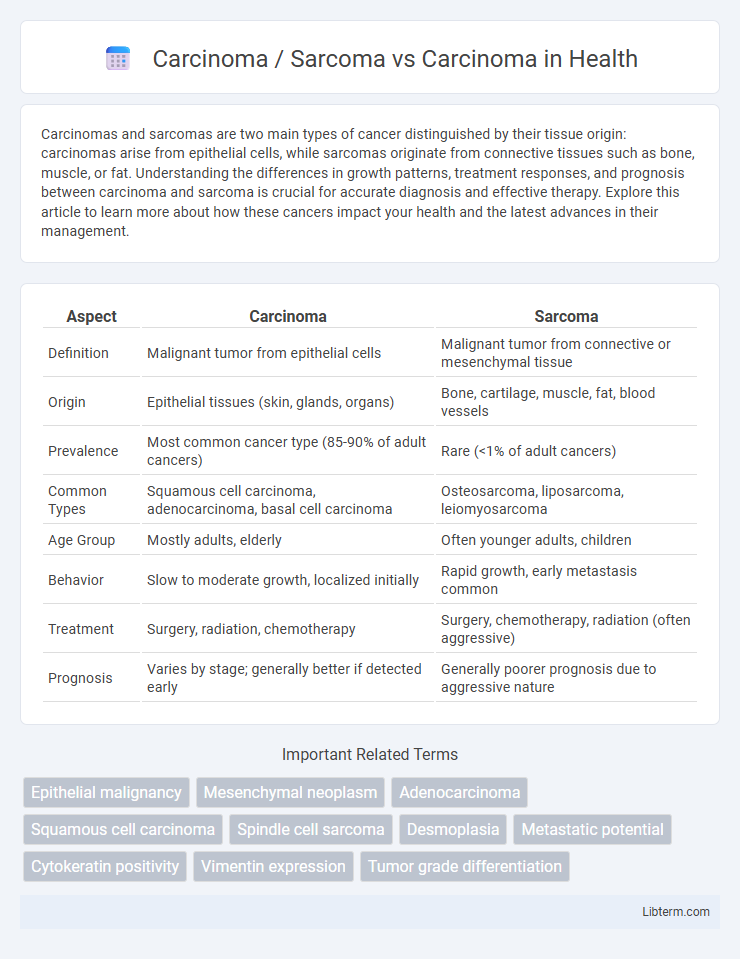Carcinomas and sarcomas are two main types of cancer distinguished by their tissue origin: carcinomas arise from epithelial cells, while sarcomas originate from connective tissues such as bone, muscle, or fat. Understanding the differences in growth patterns, treatment responses, and prognosis between carcinoma and sarcoma is crucial for accurate diagnosis and effective therapy. Explore this article to learn more about how these cancers impact your health and the latest advances in their management.
Table of Comparison
| Aspect | Carcinoma | Sarcoma |
|---|---|---|
| Definition | Malignant tumor from epithelial cells | Malignant tumor from connective or mesenchymal tissue |
| Origin | Epithelial tissues (skin, glands, organs) | Bone, cartilage, muscle, fat, blood vessels |
| Prevalence | Most common cancer type (85-90% of adult cancers) | Rare (<1% of adult cancers) |
| Common Types | Squamous cell carcinoma, adenocarcinoma, basal cell carcinoma | Osteosarcoma, liposarcoma, leiomyosarcoma |
| Age Group | Mostly adults, elderly | Often younger adults, children |
| Behavior | Slow to moderate growth, localized initially | Rapid growth, early metastasis common |
| Treatment | Surgery, radiation, chemotherapy | Surgery, chemotherapy, radiation (often aggressive) |
| Prognosis | Varies by stage; generally better if detected early | Generally poorer prognosis due to aggressive nature |
Introduction to Carcinoma and Sarcoma
Carcinoma and sarcoma are two primary categories of cancer distinguished by their tissue origins; carcinoma arises from epithelial cells lining organs and glands, while sarcoma originates from mesenchymal tissues such as bone, muscle, fat, or connective tissue. Carcinomas represent the majority of cancer cases, including common types like lung, breast, and colorectal cancer, often exhibiting aggressive growth and potential for metastasis. Sarcomas are rarer, encompassing diverse subtypes like osteosarcoma and liposarcoma, characterized by distinct biological behavior and treatment responses compared to carcinomas.
Carcinoma: Definition and Origins
Carcinoma is a type of cancer that originates from epithelial cells, which line the internal and external surfaces of the body, including skin, glands, and organs. It is the most common form of cancer, encompassing subtypes such as adenocarcinoma, squamous cell carcinoma, and basal cell carcinoma. Unlike sarcomas that arise from connective tissues like bone, muscle, and cartilage, carcinomas primarily develop in tissues derived from the ectoderm and endoderm layers.
Sarcoma: Definition and Origins
Sarcoma is a type of malignant tumor originating from mesenchymal cells, which include connective tissues such as bone, cartilage, fat, muscle, and blood vessels. Unlike carcinoma, which arises from epithelial cells lining organs and tissues, sarcomas develop deep within soft tissues or bone. Understanding the distinct cellular origins of sarcoma is crucial for accurate diagnosis and targeted treatment strategies.
Key Differences: Carcinoma vs Sarcoma
Carcinoma originates from epithelial cells lining organs and surfaces, whereas sarcoma arises from mesenchymal tissues such as bone, muscle, and connective tissue. Carcinomas are the most common type of cancer, typically affecting organs like the lung, breast, and prostate, while sarcomas are rarer and present in soft tissues and bones. The treatment and prognosis differ significantly, with carcinomas generally responding to therapies targeting epithelial cells and sarcomas requiring approaches tailored to mesenchymal malignancies.
Types of Carcinomas
Carcinomas are malignant tumors originating from epithelial cells, with common types including adenocarcinoma, squamous cell carcinoma, and basal cell carcinoma, each arising from glandular, squamous, or basal epithelial tissues respectively. Sarcomas differ by arising from mesenchymal cells, affecting connective tissues like bone, muscle, and fat, and are less common than carcinomas. The most prevalent carcinomas are lung, breast, prostate, and colorectal carcinomas, highlighting their significant impact on cancer morbidity and mortality worldwide.
Types of Sarcomas
Sarcomas are a diverse group of malignant tumors originating from mesenchymal tissues such as bone, muscle, fat, and connective tissue, differing from carcinomas which arise from epithelial cells. The main types of sarcomas include osteosarcoma (bone), liposarcoma (fat), leiomyosarcoma (smooth muscle), and rhabdomyosarcoma (skeletal muscle). Understanding the specific sarcoma subtype is crucial for determining treatment strategies and prognosis, as each type exhibits distinct biological behavior and therapeutic response compared to various carcinomas.
Risk Factors and Causes
Carcinomas primarily arise from epithelial cells and are often linked to risk factors such as tobacco use, prolonged exposure to ultraviolet radiation, and chronic inflammation. Sarcomas originate from mesenchymal tissues like bone, muscle, or fat, with causes including genetic mutations, exposure to certain chemicals, and prior radiation therapy. Understanding these distinct etiologies is crucial for targeted prevention and treatment strategies in oncology.
Symptoms and Clinical Presentation
Carcinomas typically present with symptoms related to epithelial tissue involvement, such as persistent lumps, ulcerations, or abnormal bleeding depending on the affected organ, often accompanied by localized pain or dysfunction. Sarcomas, originating from mesenchymal tissues like bone, muscle, or fat, usually manifest as deep-seated, painless masses that progressively enlarge, sometimes causing swelling or functional impairment of adjacent structures. Clinical presentation differences are crucial for diagnosis, as carcinomas frequently show mucosal or skin lesions with early surface involvement, whereas sarcomas often remain asymptomatic until significant tumor growth occurs.
Diagnosis: Carcinoma vs Sarcoma
Diagnosis of carcinoma versus sarcoma relies heavily on histopathological examination, where carcinoma originates from epithelial cells and sarcoma arises from mesenchymal tissues such as bone, muscle, or connective tissue. Imaging techniques like MRI and CT scans assist in assessing tumor location and invasion, but biopsy and immunohistochemistry remain essential for definitive differentiation based on cellular markers. Molecular testing may further distinguish specific subtypes, aiding in tailored treatment planning and prognostication.
Treatment Approaches and Prognosis
Carcinomas typically arise from epithelial cells and respond well to treatments such as surgery, radiation, and chemotherapy, with prognosis varying based on stage and subtype. Sarcomas originate from mesenchymal tissues like bone, muscle, or fat, often requiring a combination of surgery and specialized chemotherapy or targeted therapy, with prognosis generally less favorable due to aggressive behavior and late diagnosis. Treatment approaches and survival rates differ significantly between carcinoma and sarcoma, reflecting their distinct biological behaviors and therapeutic sensitivities.
Carcinoma / Sarcoma Infographic

 libterm.com
libterm.com